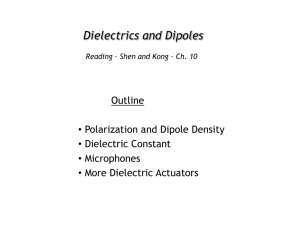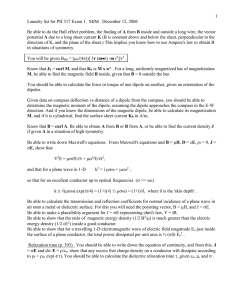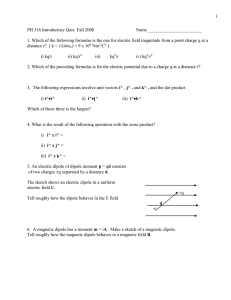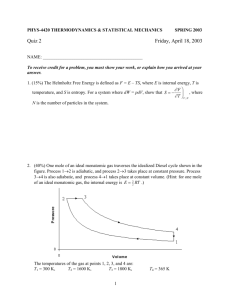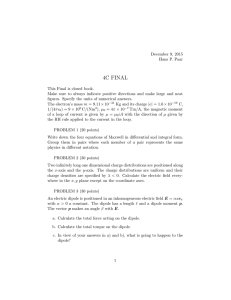Dielectrics and Dipoles
advertisement
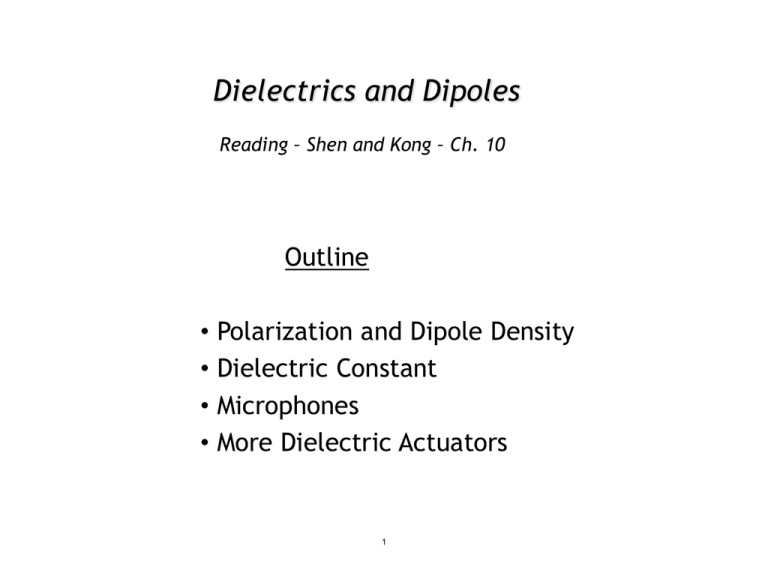
Dielectrics and Dipoles Reading – Shen and Kong – Ch. 10 Outline • Polarization and Dipole Density • Dielectric Constant • Microphones • More Dielectric Actuators 1 True or False? 1. The magnetic moment is defined as m=ia and has units of Amp-m2 2. In a linear magnetic material, the magnetization is given by where is the magnetic susceptibility with units of m3 3. The energy stored in the magnetic field is (½ µoH2)·(Volume) and has units of Joules. 2 NI 2πr Electric Fields Magnetic Fields 3 Air Capacitors d 4 … let’s insert a metal sheet between capacitor plates d - Capacitance increases - Since σ remained the same then decreases 5 … let’s insert an insulator sheet between capacitor plates d - Capacitance increases - Since σ remained the same then decreases 6 Why is there σdielectric ? What is the magnitude of σdielectric ? When molecules are in an electric field they get stretched Electric field polarizes molecules … … turns them into DIPOLES 7 small amount of charge moved by field E What is a Dipole ? - + + + + + + - - - - + + + + + + - external E filed stretches the atom/molecule - - NO external E filed Dipole Moment = electric dipole moment, p (or electric dipole for short), is a measure of the polarity of a system of electric charges. Here x is the displacement vector pointing from the negative charge to the positive charge. This implies that the electric dipole moment vector points from the negative charge to the positive charge. Note that the electric field lines run away from the positive charge and toward the negative charge. There is no inconsistency here, because the electric dipole moment has to do with the positions of the charges, not the field lines. 8 Analogy Between Magnetic and Electric Dipoles Magnetic Fields Electric Field Magnetic Moment Electric Dipole Moment m=qd m=ia 9 Superposition The magnetization or net magnetic dipole moment density is given by [A/m] The polarization or net electric dipole moment density is given by [C/m2] Number of dipoles per unit volume [m-3] average magnetic dipole moment [A m2] 10 Number of dipoles per unit volume [m-3] average electric dipole moment [C m] Induced Magnetization For some materials, the net magnetic dipole moment per unit volume is proportional to the H field MAGNETIC SUSCEPTIBILITY (dimensionless) units of both M and H are A/m. The effect of an applied magnetic field on a magnetic material is to create a net magnetic dipole moment per unit volume M 11 Induced Polarization Density of dipoles…. Electric field polarizes molecules… … equivalent to … polarization density, P (a.k.a electric polarization, or simply polarization) - density of permanent or induced electric dipole moments in a dielectric material. The SI unit of measure is coulombs per square meter. 12 electric susceptibility of a dielectric material is a measure of how easily it polarizes in response to an electric field Origin of the Dielectric Response + Polarizability, α, tells us how easy is to disturb charge distribution, like the electron cloud of an atom or molecule, from its normal shape by an external electric field. 1. Electronic Polarizability (αe) Polarization of localized electrons - 2. Ionic Polarizability (αi) Displacement of ions + - + 3. Dipolar Polarizability (αd) Polarizability (α) increases Response Time Increases (slower response) Reorientation of polar molecules + - 4. Space Charge Polarizability (αs) Long range charge migration 13 Bound Charges and Polarization - + + + + + + low dipole density 14 high dipole density negative interface charge - - … let’s insert an insulator sheet between capacitor plates d equivalently … 15 … let’s insert an insulator sheet between capacitor plates Electric displacement D equivalently … d 16 Displacement Fields where we define electric displacement field, D, as Displacement field D accounts for the effects of unbound (“free”) charges within materials. Electric field E accounts for the effects of total charges (both “bound” and “free”) within materials. 17 Ferroelectrics A ferroelectric material develops a spontaneous polarization (builds up a charge) in response to an external electric field • The polarization does not go away when the external field is removed • The direction of the polarization is reversible • Examples BaTiO3 PbTiO3 Applications of Ferroelectric Materials • Non-volatile FRAM (Ferroelectric Random Access Memory) 18 Why Worry About Dielectrics ? Gate Gate 3.0 nm high-k dielectric 1.2 nm SiO2 Silicon Substrate Silicon Substrate Existing 90 nm process Drain Terminal Capacitance = 1.6x Leakage current = 1x Leakage current = 0.01x Gate Terminal Metal P Type P Type N Type A potential high-k process Capacitance = 1x Image by MIT OpenCourseWare. Source Terminal Capacitor in 90, 65nm Capacitor in 45nm SiO2 e/eo =3.9 HfO2 e/eo =25 As transistors scale, insulation within the capacitor has become leaky… 19 Energy Density of the Electric Field What is the energy density stored in the capacitor ? For a capacitor with large, flat plates… The electric field is not just the origin of electrostatic forces but also tells us about the stored energy ! 20 Linear Dielectric Slab Actuator Note: We are going to keep Q constant on the plates 21 Electromagnetic Energy Storage Remember … Magnetic Electric Magnetic machine Electric machine 22 Key Takeaways Electric displacement Magnetic Electric 23 MIT OpenCourseWare http://ocw.mit.edu 6.007 Electromagnetic Energy: From Motors to Lasers Spring 2011 For information about citing these materials or our Terms of Use, visit: http://ocw.mit.edu/terms.
